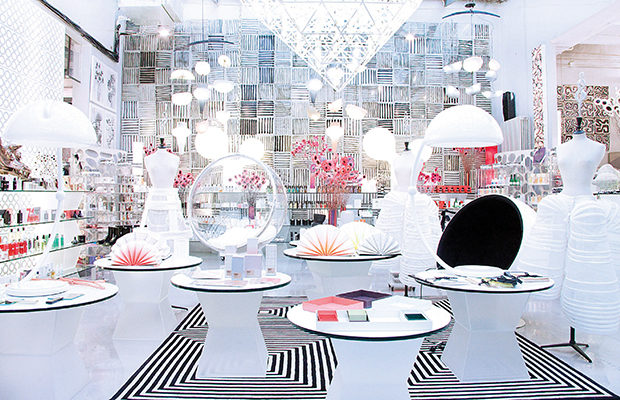 10 Corso Como’s concept store, founded in 1990 by Carla Sozzani. COURTESY OF 10 CORSO COMO.
10 Corso Como’s concept store, founded in 1990 by Carla Sozzani. COURTESY OF 10 CORSO COMO.
Design
Milan: A Design Metropolis
PORTA VOLTA IN MILAN, named after a gate in the sixteenth-century walls that once surrounded the city, has become symbolic of radical changes that have taken place on the back of the 2015 Milan Expo. The area had never really established its own identity before because of its location on the edge of the city, connecting Chinatown on via Paolo Sarpi—which has itself been subject to rapid gentrification—to the area around the Garibaldi railroad station.
Where there was a small bamboo forest and a greenhouse of exotic plants, office workers employed by a technology giant now toil away behind reflective windows. Once occupied by Fratelli Ingegnoli, a wellknown garden center, this green space has been replaced by the Feltrinelli Porta Volta complex, a striking piece of architecture designed by the Swiss firm Herzog & de Meuron. Since its completion in 2016, the two buildings that comprise the complex have been occupied by Microsoft and the Fondazione Giangiacomo Feltrinelli, a foundation linked to a major Italian bookshop chain and publisher and dedicated to research on economic, political, and social thought and history.
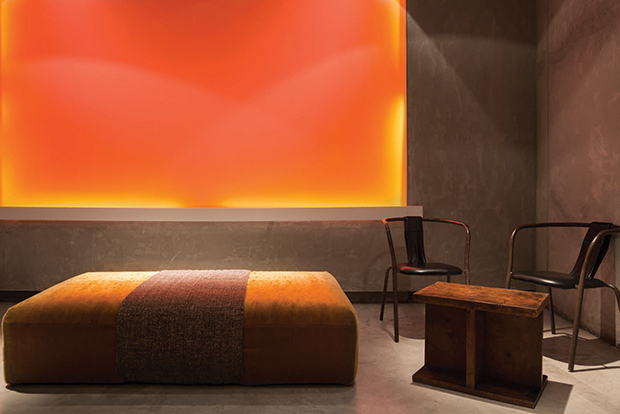
A meeting room in the Straf hotel. COURTESY OF STRAF.
Just down the road—past Princi, a bakery with several branches that has become a Milan staple—gooey mozzarella and freshly sliced prosciutto draw visitors to Eataly, an indoor market that began in Turin and now has a network of branches that extends to international cities like New York. At the center of three busy floors of stalls and restaurants is a small stage for performances, paying homage to the Teatro Smeraldo, a historic theater that once stood here.
The universal expositions that gave rise to such major public projects in the 1800s as the Crystal Palace in London and the Eiffel Tower in Paris, finally came to Milan in 2015. With the Expo came a wave of regeneration that has changed the city’s skyline well beyond the area of Porta Volta. Near Garibaldi station, a circle of skyscrapers has popped up around a new piazza named after designer Gae Aulenti. Designed by Cesar Pelli, it takes the form of a pedestrian platform eighty meters in diameter that rises above the roads that lead to the station, creating a series of new connections with the street, including the neighborhood of Isola (meaning island), which used to be somewhat disconnected from central Milan and was hence a place where alternative culture thrived. Among glass and steel towers, a Solar Tree designed by Ross Lovegrove and powered by natural light, now illuminates the piazza.
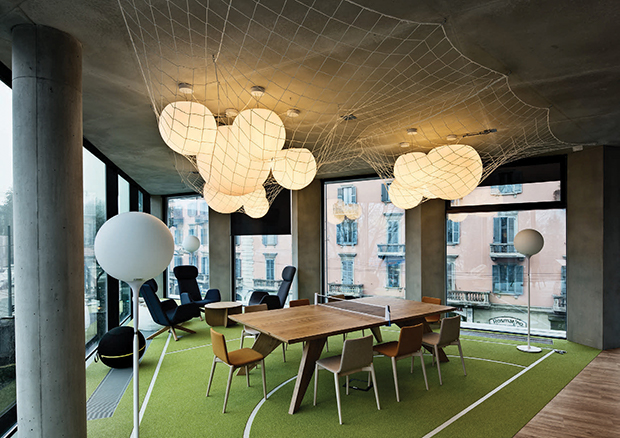
The Feltrinelli Porta Volta, designed by the Swiss architecture firm Herzog & de Meuron, is home to Microsoft Italia’s playful office space. COURTESY OF MICROSOFT ITALIA.
One reason why it is a good idea to begin a visit to Milan at Porta Volta is that it offers the best view of the city’s iconic architecture, new and old: the historic Pirelli skyscraper built in the late 1950s and designed by Gio Ponti; farther away the UniCredit Tower, now the tallest building city in the city at nearly 760 feet high; as well as the Bosco Verticale or “vertical forest” by Italian architect Stefano Boeri.
Just a few steps away is Corso Como, a pedestrian street known for some decades for its nightlife but also as a focal point for international trends. The concept store 10 Corso Como, founded in 1990 by Carla Sozzani, former editor-in-chief of Italian Elle, has not lost its standing as Milan’s chicest café, art gallery, and showcase for fashion and design, even extending its reach by opening branches in New York, Beijing, Shanghai, and Seoul. Though it also houses an intimate hotel with three suites, they are generally booked up well in advance; but another place to stay nearby is the recently opened Hotel Viu Milan with furniture by Molteni; the glass, oxidized wood, and raw metal interiors attracted interest at IMM Cologne in January.
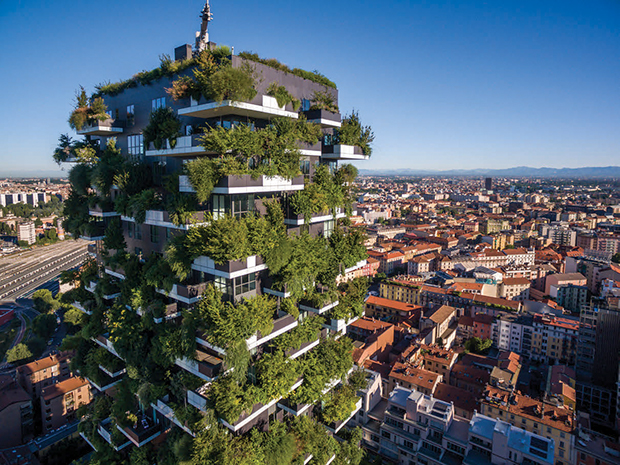
The Bosco Verticale, a “vertical forest,” by Stefano Boeri. DAVIDE PIRAS PHOTO, COURTESY OF STEFANO BOERI ARCHITETTI.
The historic center of Milan—marked by such landmarks as Castello Sforzesco, Piazza della Scala, and the Brera district—continues to be the city’s cultural backbone. While many of Milan’s historic buildings were damaged during World War II, much of the area remains intact. This includes the glorious Duomo, a neo-Gothic cathedral with lace-like roof carvings, and the nineteenth-century Galleria Vittorio Emanuele II, which houses numerous cafés and designer stores, including Prada’s flagship.
The fashion houses that came into prominence in Milan in the ‘80s—from Armani to Versace and Dolce & Gabbana—are located within walking distance of the Piazza del Duomo, on and around Via Monte Napoleone. While brands like these remain hugely significant, an awareness of fresh contemporary design and visual culture remains part of Milan’s DNA.
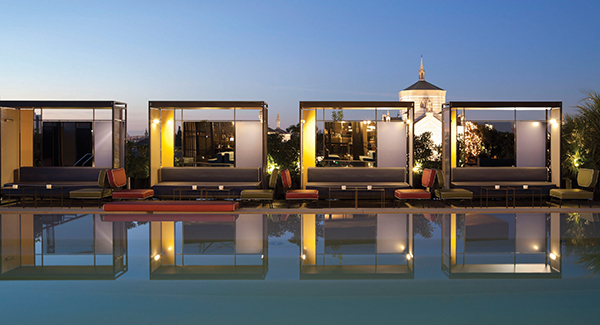
Ceresio 7, a restaurant with two swimming pools by design duo Dean and Dan Caten, aka Dsquared2. COURTESY OF CERESIO 7.
Rinascente, the city’s nineteenth-century department store, runs along one side of the Duomo and contains a Design Supermarket, an entire floor devoted to contemporary design. Next door is Straf, a modern design hotel and bar by Vincenzo De Cotiis, an interior architect known for appropriating found materials to form an industrial chic aesthetic. The Osservatorio, a new Prada Foundation space in the Galleria dedicated to contemporary photography, is also worth visiting, along with the foundation’s main site in Porta Romana, which was converted from a former distillery by OMA. Fornasetti on Corso Venezia, a store dedicated to twentieth-century Milanese design, is another gem.
The Fondazione Triennale, named after an art and design exhibition once held every three years, opened a design museum at the Palazzo dell’Arte in 2007. It exhibits a permanent collection on rotation as well as many modern and contemporary design shows. This year, these include Ettore Sottsass: There is a Planet (ended March 11, 2018) and 999: A Collection of Questions about Contemporary Living (on until April 2).
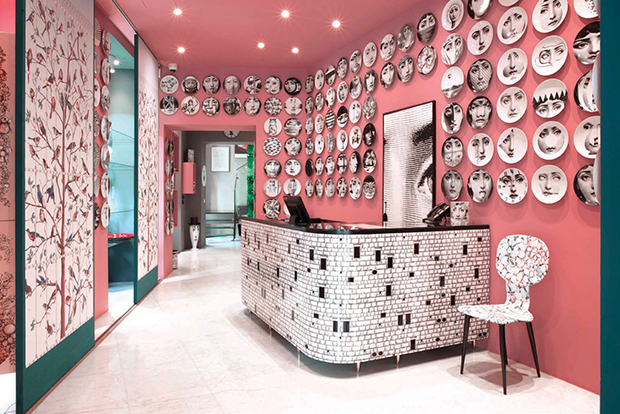
Piero Fornasetti’s iconic Tema e Variazioni plates, featuring the likeness of nineteenth-century opera singer Lina Cavalieri, line the walls of the Fornasetti store on Corso Venezia. COURTESY OF FORNASETTI.
The focus of Milan’s cultural calendar (overshadowed perhaps only by Milan Fashion Week) is the Salone del Mobile, an international furniture and design fair that will take place April 17–22. Each year, the Salone brings the Zona Tortona district to life with installations, exhibitions, and pavilions that are at least as interesting as the official fair held outside the city at Fiera Milano. Exceptionally crowded during the Salone but open all year round, Rossana Orlandi combines a gallery of international repute with a curated design store and a new restaurant called Marta.
Most Italians will tell you that Milan does not live up to the reputation of Tuscany or Puglia when it comes to food, but that is not universally true. In Tortona is the wonderful Base, combining a restaurant with an artists’ residence, creative space, and hostel. Ceresio7 by Canadian designers Dean and Dan Caten is a trendy restaurant and bar with two swimming pools overlooking Milan—located on the fourth floor of the former offices of Italian power company Enel that the design duo has converted to house its firm, Dsquared2.
Just don’t forget to pack some heels—many a Milanese woman has been known to wear them despite the abundance of cobbled streets.









